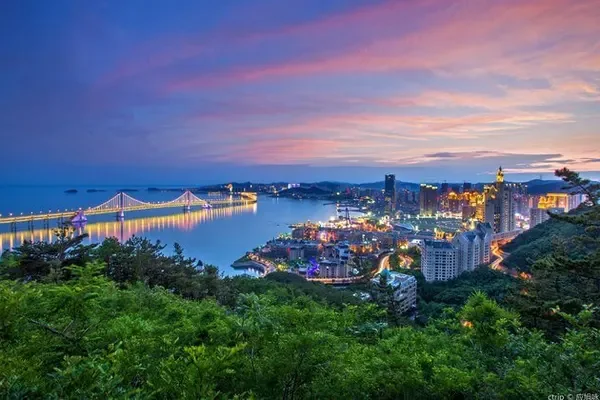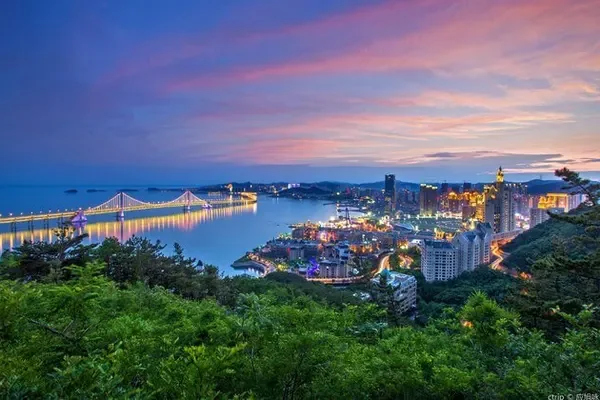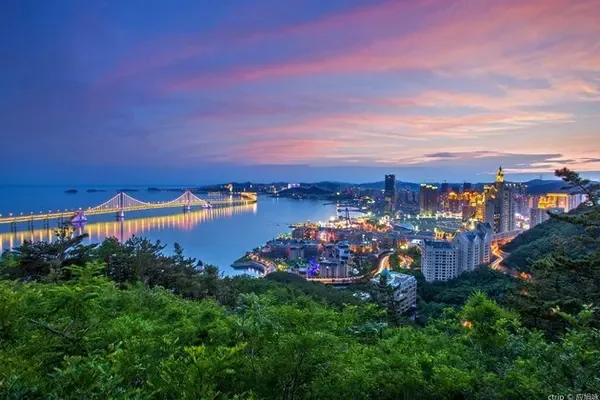Beijing Baiyun Temple is located outside the Xibian Gate of Beijing. Since it is not far from my home, I passed by its gate many times. Although I have always felt in my heart that this is a very solemn and mysterious temple. Especially during the Spring Festival, the temple fair here is full of tourists and very lively. But despite this, the reporter has never been able to go in and have a look.

On November 4, 2020, it happened to be a sunny day, and I finally decided to walk into Baiyun Temple, so I also experienced the profound Taoist culture here, which can be said to have benefited a lot. The first thing that catches people's eyes before coming to Baiyun Temple is a long red screen wall in front of the temple.

Zhaobi, also known as Yingbi, is facing the archway of Baiyun Temple. There are four big characters "Eternal Changchun" embedded on the screen wall, which were written by Zhao Mengfu, a great calligrapher in Yuan Dynasty. Absolutely. In front of the temple not far from the screen wall is the cultural relic stele of Baiyun Temple, a national key cultural relic protection unit announced by the State Council of the People's Republic of China on June 25, 2001, and established by the Beijing Municipal Bureau of Cultural Relics in October 2001.

Before coming here, the reporter also made a brief introduction, knowing that Baiyun Temple in Beijing is the ancestral home of the Taoist Quanzhen Longmen sect, and enjoys the reputation of "the first jungle in Quanzhen". Now it is the seat of China Taoist Association, China Taoist Academy and China Taoist Culture Research Institute. In the minds of Taoists, Baiyun Temple has a lofty status. Today's Baiyun Temple is a major scenic spot and historical site in the capital Beijing. With its unique charm, it attracts pilgrims and tourists from all over the world. It is an important window for people to understand Chinese Taoist culture and traditional customs.

Bypassing the screen wall and facing the colorful Baiyun Guan archway with carved beams and painted buildings. This archway was originally the Lingxing Gate, which was a place for Taoist priests to watch the stars. Later, Lingxing Gate evolved into an archway. This archway was built in the eighth year of Zhengtong in the Ming Dynasty (1443). . There is a book on the archway: Dongtian Shengjing, and the reverse side is: Qionglin Langyuan. It means fairyland on earth, a treasure land of geomantic omen.

Walking through the gate tower is the gate of Baiyun Temple under the shade of green trees. The mountain gate is a stone arch with three coupons. Above the main entrance is a plaque called "Chijian Baiyun Temple", which was bestowed by Emperor Yingzong of the Ming Dynasty. This plaque is made of cast iron, and its implication is to hope that Baiyun Temple will be strong and durable, like iron casting.

The three gates symbolize the "Three Realms", and stepping into the mountain gate means jumping out of the "Three Realms" and entering the Immortal Cave. On the stone wall of the mountain gate are engraved with flowing clouds, cranes, flowers and other patterns. The knife technique is strong and the shape is exquisite. There is a palm-sized stone monkey hidden in the relief on the east side of the coupon gate in the middle. There is such a legend in old Beijing: "The gods have no trace. , leaving only the stone monkey in the temple.” The stone monkey has become the incarnation of a god, and visitors who come to Baiyun Temple have to touch it with their hands for good luck. I feel that I have been touched and it is not very clear.

In fact, there are three little stone monkeys in Baiyun Temple, which are hidden in different places. But after looking around in the temple, I only found the second one besides the touch monkey at the mountain gate. No wonder tourists say that if you don't look for it sincerely, it's hard to see it, so there is a saying in Baiyun Temple that "three monkeys don't meet each other".

I was lucky that day, just in time to catch up with a few tourists who came here to pay their respects and hired a tour guide, so the reporter and his party also accompanied them. On both sides of the gate of Baiyunguan Mountain are Huabiao, which was called "slander wood" in ancient times, and it is said that it was set up for Yao and Shun to accept advice. Later, it became the symbol of palaces and imperial mausoleums, and palaces conferred by the emperor's order can be set with Huabiao. The Baiyun Guanhua Biao is placed in front of the mountain gate, which indicates the boundary with the secular world, and at the same time plays the role of a solemn palace.

Entering the mountain gate is the spacious and tidy courtyard of Baiyun Temple, facing Wofeng Bridge, which is a single-hole stone bridge running from north to south. There is no water under the Wofeng Bridge, and a model of an ancient copper coin is hung on both sides of the bridge hole, engraved with the words "bell rings Zhaofu", and a small copper bell is tied in the eye of the coin. It is said that due to the strong wind and less rain in the north, there was a "Ganyu Bridge" outside the temple, so people built this "Wofeng Bridge" inside the temple. The two bridges symbolize the meaning of good weather.

After passing through the Wofeng Bridge, there is the Lingguan Hall, where the Taoist Dharma protector King Lingguan is enshrined. The statue is a woodcarving of the Ming Dynasty, about 1.2 meters high, with a red face, beard, and wide-eyed eyes. The left hand makes a formula, and the right hand holds a whip. The image is mighty and the proportion is moderate. Beautifully shaped. On the left wall are portraits of Zhao Gongming and Ma Sheng, and on the right wall are portraits of Wen Qiong and Yue Fei. These are the four guardian marshals of Taoism.

Walking in Baiyun Temple, I feel that it is really too big. The whole palace complex is divided into three roads, namely middle, east and west, and the backyard, with a grand scale and a compact layout.

After entering from Baiyunguan Middle Road, I passed Zhaobi, Pailou, Huabiao, etc. and entered the mountain gate. After entering the mountain gate, I saw Wofeng Bridge, Lingguan Hall, Bell and Drum Tower, Sanguan Hall, Caishen Hall, Jade Emperor Hall, Salvation Hall, Qiuzu Hall and Sanqing. There are many temples such as the Four Palaces, each building is located in the temple with its own characteristics formed by the name of the temple, which is impressive.

For example, the Jade Emperor Hall in Baiyun Temple is dedicated to the Jade Emperor. The statue is a woodcarving of the Ming Dynasty, about 1.8 meters high, wearing a nine-chapter robe, wearing a crown of twelve rows of beads, holding a jade wat in his hand, and sitting on a dragon chair. There are many banners hanging in front of and on both sides of the shrine, on which are embroidered many "shou" characters in seal script in different colors. There are a total of one hundred, so they are called "Hundred Shou Banners". This banner was given by the Empress Dowager Cixi.

The six bronze statues on the left and right sides of the Jade Emperor Statue were all cast during the Wanli period of the Ming Dynasty. There are a total of eight fine brushwork and color paintings on silk at Erbasu, all of which are masterpieces of the Ming and Qing Dynasties.

Qiu Zudian enshrines Qiu Chuji, the ancestor of the Quanzhen Longmen School, Changchun Daoist Qiu Chuji. In the center of the hall, there is a huge "gall bowl", which is carved from the root of an ancient tree. It was given by Emperor Yongzheng of the Qing Dynasty. , You can carry this bowl to the palace to raise money, and there will be alms in the palace. Qiu Chuji's slough was buried under this "gall bowl".

The Hall of Salvation of Suffering is enshrined in the Taiyi Salvation of Suffering God. Tianzun rides nine lions, holds a bottle of nectar in his left hand and a sword in his right. According to the Taoist scriptures: Taiyi Saves Suffering Tianzun is a merciful and merciful god who specially saves those who unfortunately fall into hell. The Hall of Suffering and the Hall of the King of Medicine were originally the "Palace of the Great Master", dedicated to the eighteen disciples who accompanied Qiu Chuji to the Daxue Mountain in the Western Regions. After the statues were destroyed, there were no statues of the eighteen masters, so they were changed to the Hall of Salvation of Suffering and the Hall of the King of Medicine respectively. .

The Sanguan Hall enshrines the "Three Officials" of heaven, earth and water. Legend has it that the heavenly official blesses, the earthly official forgives sins, and the water official relieves misfortune. In addition to the single-storey building, there are also multi-storey temples in Baiyun Temple.

For example, the Sanqing and Siyu Palace has two floors, the upper floor is dedicated to the Sanqing, and the lower floor is dedicated to the Siyu. The statue of the Sanqing was built during the Xuande period of the Ming Dynasty. It is more than 2 meters high. Quaint.

The Four Royals are the four heavenly emperors who assisted the Jade Emperor: Gouchen Shanggong Emperor, Antarctic Changsheng Emperor, Zhongtian Ziwei North Pole Emperor and Houtuhuang Dizhi. The statues are all clay sculptures in the mid-Qing Dynasty with golden lacquer and powder, about 1.5 meters high . The gilt bronze tripod furnace in the courtyard in front of the hall was cast during the Jiajing period of the Ming Dynasty. The censer has a thick shape, with exquisite cloud and dragon patterns carved all over it, and there are 43 golden dragons in total.

There are Shente, Ancestral Hall, Eight Immortals Hall, Luzu Hall, Yuanjun Hall, Wenchang Hall, Yuanchen Hall, etc. on the west road of Baiyun Temple. The deity is a bronze beast resembling a steed, with a mule body, donkey face, horse ears, and ox hooves. In fact, its correct name is "special". It is said that it is a kind of divine beast with unique functions. Wherever a person feels uncomfortable, he only needs to touch himself first, and then touch the same part of it, and the illness can be cured. The reporter and his party specially invited passers-by to take a precious photo in front of Shente.

Taking a photo in front of Baiyun Guanshen
In addition, the Wenchang Hall in the West Road is also very distinctive, especially the tall bronze statue outside the gate is "Kuixing", which is the god who dominates the rise and fall of articles. Holding a bucket in the left hand means the character "Dou" in the middle of the word "Kui", and holding a pen in the right hand means to use the pen to mark the name of the pilot.

It is said that he first "pointed" the ink bucket with a pen, and then "pointed" it on the exam questions. The one who hits the mark first is the winner, that is, the first or the "first champion". This is called "Kuixing Diandou". This plot can often be seen in folk performances. He has a big belly, which means that he is highly knowledgeable and full of economics.

There are Luogong Pagoda, Sanxing Hall, Cihang Hall, Zhenwu Hall and Leizu Hall on Baiyunguan East Road. It is worth mentioning that the Luogong Pagoda is located in a pagoda courtyard in the northeast corner. The Luogong Pagoda is octagonal in shape and has a brick and stone structure. In front of the original pagoda, there are four stone steles enshrining the statue of Luo Gong, the "Front Hall of Luo Gong", the "Reconstruction Monument of Baiyun Temple", "The Monument of Luo Zhenren's Way", "The Stele of the Porridge Field", and "The Monument of Abbot Yunxi's Merit and Virtue". Save the Luogong Pagoda.

Luo Gong was a native of Jiangxi. He came to Beijing during the Kangxi period and lived in Baiyun Temple. He died in the fifth year of Yongzheng (1727). According to folklore, Luo Zhenren created the tools and massage techniques for shaving and hairdressing. After being introduced to the palace, he was appreciated by Emperor Yongzheng. In the old days, the hairdressing industry honored Luo Zhenren as the ancestor.

The backyard of Baiyun Temple is a quiet and elegant garden, named Yunji Garden, also known as "Little Penglai". The courtyard is centered on Jietai and Yunjishanfang, with scattered rockeries, surrounded by corridors, Yunhua Xianguan, Youhe Pavilion, Miaoxiang Pavilion, and Tuiju Building. The trees are shady, fresh and quiet, making people linger and forget to return.

Jietai is the mandala where the Quanzhen sect of Taoism imparts the "Three Altars and Great Precepts", and the Yunji Shanfang is the place where Quanzhen Taoist lawyers preach scriptures to disciples. In 1989 of the last century, Baiyun Temple held the first Quanzhen sect transmission ceremony since the founding of New China, which was an unprecedented event.

In addition, the twelve zodiac signs in Baiyun Temple, the corridor of inscriptions, the murals of 24 filial piety stones, and the ink stone carvings of Mr. Sun Yat-sen are all remarkable and have high ornamental value. Among them, the walls of the twelve zodiac signs are very finely carved and lifelike, and each zodiac sign has its auspiciousness.

In addition, Baiyun Guandao also relies on its advantages in Guannei resources, is keen to serve the society, and actively participates in public welfare and charity activities. Good deeds such as exempting personnel from all expenses have been praised by many parties.

Looking back at history, the predecessor of Baiyun Temple was Tang Tianchang Temple. According to Tang Liu Jiuxiao's "Rebuild Tianchang Temple Stele", Tang Xuanzong built this temple to worship Taoism and worship Lao Tzu. It is one of the few temples in Beijing that has not been destroyed.

In the seventh year of Jin Dading (1167), it was ordered to be rebuilt, and Jin Shizong named it "Tianchang Temple in Ten Directions". In the second year of Taihe, Tianchang temple was burned down by fire unfortunately. Later, it was renamed "Tai Chi Palace".

At the beginning of the Yuan Dynasty, Qiu Chuji visited Genghis Khan from the Daxue Mountain in the Western Regions, returned to Yanjing in the east, and gave him a residence in Taiji Palace. In May of the 22nd year of Yuan Taizu, Genghis Khan ordered Taiji Palace to be changed to "Changchun Temple". In the early Ming Dynasty, it was renamed Baiyun Temple. In the early Qing Dynasty, another large-scale reconstruction of Baiyun Temple was carried out under the auspices of Abbot Wang Changyue, which basically established the scale of Baiyun Temple today.

In the history of Baiyun Temple, there have been many eminent figures, among whom Qiu Chuji in the late Song Dynasty and early Yuan Dynasty and Wang Changyue in the middle Qing Dynasty made the greatest contributions. Qiu Chuji is an important founder of the Quanzhen School of Taoism. His thought of integrating the three religions into one, his practice of helping the world and saving the people, and his contributions to the promotion of traditional Chinese culture and cultural exchanges with foreign countries have had a great influence on the time and later generations. influences.

According to the reporter, in view of the large scale of the Baiyun Temple and the many landscapes such as the halls and the worshiped gods, stone murals, cultural relics and historic sites, it will not take a long time if you want to observe everything carefully and all over the place. Difficult to do. However, during the more than an hour of the reporter's visit, what he saw and heard was enough to make people deeply feel the profound Taoist culture here. Although two years have passed in a blink of an eye, the scene of wandering in the Baiyun Temple is still fresh in my memory and has endless aftertaste. (Photo: Feng Ganyong)



